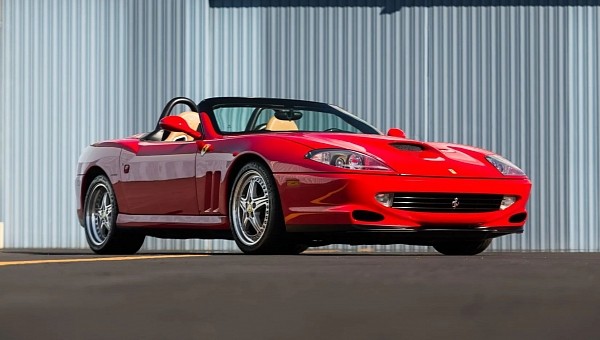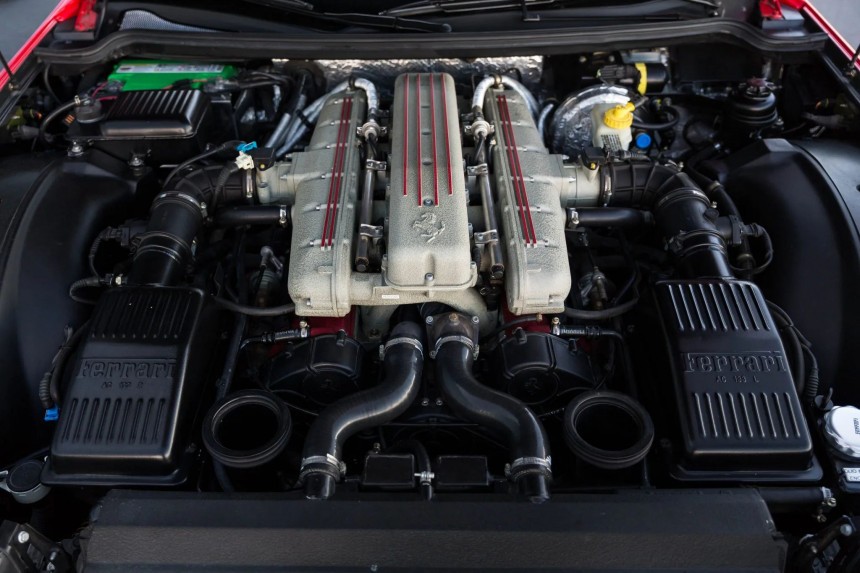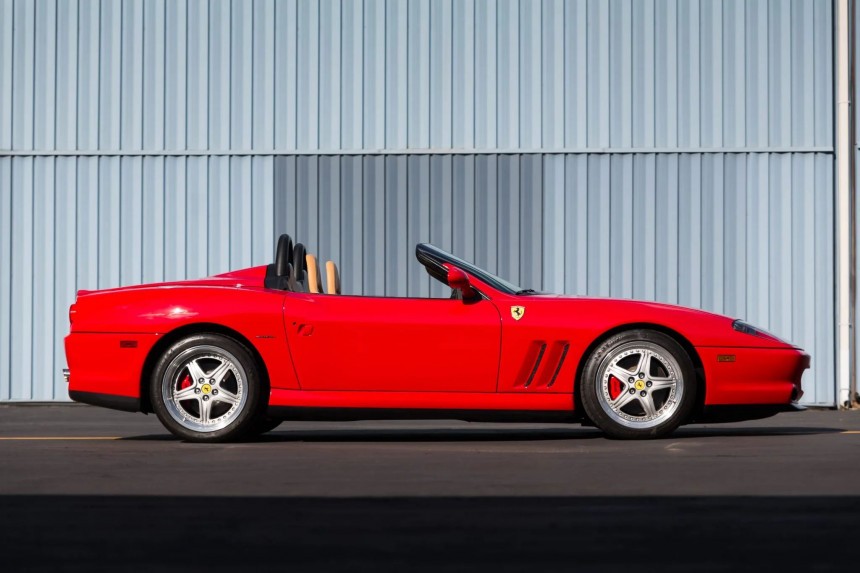The Maranello series of grand tourers went official in 1996 as the successor of the F512 M. The final version of the long-running Testarossa is a midship with flat-12 muscle, whereas the Maranello is a front-engine affair with 12 cylinders arranged in two banks at 65 degrees from one another. From this exclusively technical viewpoint, Ferrari enthusiasts consider the elegant berlinetta to be the successor to the Daytona.
Indeed, the 365 GTB/4 Daytona rolled out in 1968, only to be joined by the GTS/4 Daytona in 1971. In stark contrast to its predecessor, the Maranello never came with an optional canvas top. Customers had the possibility of specifying a limited-edition roadster by the name of Barchetta Pininfarina, which we’ll be covering in a few paragraphs’ time.
The Maranello series kicked off with the 550, which may have seemed a bit strange back in 1996. The 456 four-seat gran turismo, for example, is named this way after each cylinder’s displacement in cubic centimeters. It was the Prancing Horse’s last use of the naming convention until Ferrari made a surprising U-turn with the 488 series of mid-engine supercars.
Dividing 550 by 10 gets you 5.5 liters, the displacement of the naturally-aspirated V12 hiding under the Maranello’s hood. This nomenclature applies to the subsequent 575M as well, with M standing for Modificata.
As opposed to the Colombo-derived V12 from the good old days, the Maranello series adopted a newly-designed powerplant with five additional degrees between the cylinder banks. This engine family is lovingly referred to as the Dino V12, for it’s greatly inspired by the Dino V6 and V8 engines. For example, the 65-degree V angle matches that of the V6-powered Dino 246 and Lancia Stratos. The 88-millimeter bore and 75-millimeter stroke, meanwhile, are shared with the V8-powered 348.
As opposed to F116 in the 456, the Maranello-specific F133 develops anything between 478 and 597 horsepower. Peak torque ranges from 420 pound-feet (569 Nm) at 5,000 revolutions per minute for the 550 Maranello and to 538 pound-feet (730 Nm) for the 575 GTC racing car.
The alloy engine uses cylinder liners coated with Nikasil, a trademarked coating introduced by Mahle in 1967, originally for Wankel-type powerplants. Taking its name from nickel silicon carbide, Nikasil minimizes friction, thus allowing large cylinder bores with tight tolerances. The Prancing Horse discontinued the Dino V12 in 2011 after the 612 Scaglietti ran its course, replacing it with the F140 series. Continuously developed since the introduction of the Enzo, the F140 soldiers on with up to 829 ponies on tap from the 6.5-liter colossus in the Daytona SP3.
Overseen by Lorenzo Ramaciotti yet penned by Elvio D'Aprile, the 550 Maranello wasn’t unveiled in Maranello. The Italian automaker used the Nurburgring in Germany for the car’s introduction, which is somewhat weird given that Ferrari only cares about lap times at the Fiorano circuit.
Offered between 1996 and 2001, the 550 Maranello was exclusively offered with an oh-so-fabulous gated manual transmission. Back then, Ferrari didn’t care as much about lap times and zero-to-60 bragging rights as it does today. It’s also worth noting that Ferrari offered a torque-converted auto in the 456 GTA and that the semi-automatic transmissions from that era left much to be desired compared to modern-day DCTs.
Built around a tubular steel space frame with soldered aluminum body panels, the 550 Maranello uses double wishbones, coaxial dampers, and coil springs at every corner. 18-inch magnesium alloys need to be mentioned as well, along with four-way ABS and anti-slip regulation.
A little over 3,800 units of the 550 Maranello were produced, whereas the much rarer 550 Barchetta Pininfarina was capped at 448 units. Ferrari originally wanted to make 444, but tetraphobia concerns in the Japanese market convinced the Maranello-based automaker to change its mind.
Number 4 is avoided in hospitals and apartments, and 49 is considered unlucky as well. Its pronunciation is extremely similar to shiku, which translates to nasty stuff that every single one of us will eventually experience. Number 9 is avoided in the Land of the Rising Sun as well.
Presented at the 2000 Paris Motor Show to celebrate Pininfarina’s 70th anniversary, the 550 Barchetta Pininfarina was offered exclusively to existing customers. Already spoken for before the first example rolled off the assembly line, this roadster-styled grand tourer is extremely collectible in this day and age, partially because it features a gated manual tranny.
Chassis number ZFFZR52AX10124344 is one of those rarefied machines. Listed as #366 on the interior plaque, this fine-looking modern classic was initially titled in Colorado. Subsequently registered in California and New Hampshire, it currently slumbers in California. Purchased by the seller in 2017, the car shows fewer than 11k miles (17k kilometers) on the odo.
Tastefully specified in Rosso Corsa over tan leather upholstery for the carbon-backed seats, #366 still features the factory canvas top intended for temporary use at speeds no higher than 70 miles per hour (113 kilometers per hour). It further sports 19-inch alloy wheels specific to the 550 Barchetta Pininfarina, as well as the Ferrari Classiche Red Book, which lists July 2001 as the delivery date and Ferrari of Denver as the dealer.
The 550 Barchetta Pininfarina usually goes for more than $200,000 at auction, sometimes hammering for more than $300,000 based on the most recent results. ZFFZR52AX10124344 currently stands on a high bid of $170,000 after 15 expressions of interest, which is most likely under the seller’s reserve price. The auction ends on January 7th at 8:00 pm.
The Maranello series kicked off with the 550, which may have seemed a bit strange back in 1996. The 456 four-seat gran turismo, for example, is named this way after each cylinder’s displacement in cubic centimeters. It was the Prancing Horse’s last use of the naming convention until Ferrari made a surprising U-turn with the 488 series of mid-engine supercars.
Dividing 550 by 10 gets you 5.5 liters, the displacement of the naturally-aspirated V12 hiding under the Maranello’s hood. This nomenclature applies to the subsequent 575M as well, with M standing for Modificata.
As opposed to the Colombo-derived V12 from the good old days, the Maranello series adopted a newly-designed powerplant with five additional degrees between the cylinder banks. This engine family is lovingly referred to as the Dino V12, for it’s greatly inspired by the Dino V6 and V8 engines. For example, the 65-degree V angle matches that of the V6-powered Dino 246 and Lancia Stratos. The 88-millimeter bore and 75-millimeter stroke, meanwhile, are shared with the V8-powered 348.
As opposed to F116 in the 456, the Maranello-specific F133 develops anything between 478 and 597 horsepower. Peak torque ranges from 420 pound-feet (569 Nm) at 5,000 revolutions per minute for the 550 Maranello and to 538 pound-feet (730 Nm) for the 575 GTC racing car.
Overseen by Lorenzo Ramaciotti yet penned by Elvio D'Aprile, the 550 Maranello wasn’t unveiled in Maranello. The Italian automaker used the Nurburgring in Germany for the car’s introduction, which is somewhat weird given that Ferrari only cares about lap times at the Fiorano circuit.
Offered between 1996 and 2001, the 550 Maranello was exclusively offered with an oh-so-fabulous gated manual transmission. Back then, Ferrari didn’t care as much about lap times and zero-to-60 bragging rights as it does today. It’s also worth noting that Ferrari offered a torque-converted auto in the 456 GTA and that the semi-automatic transmissions from that era left much to be desired compared to modern-day DCTs.
Built around a tubular steel space frame with soldered aluminum body panels, the 550 Maranello uses double wishbones, coaxial dampers, and coil springs at every corner. 18-inch magnesium alloys need to be mentioned as well, along with four-way ABS and anti-slip regulation.
A little over 3,800 units of the 550 Maranello were produced, whereas the much rarer 550 Barchetta Pininfarina was capped at 448 units. Ferrari originally wanted to make 444, but tetraphobia concerns in the Japanese market convinced the Maranello-based automaker to change its mind.
Presented at the 2000 Paris Motor Show to celebrate Pininfarina’s 70th anniversary, the 550 Barchetta Pininfarina was offered exclusively to existing customers. Already spoken for before the first example rolled off the assembly line, this roadster-styled grand tourer is extremely collectible in this day and age, partially because it features a gated manual tranny.
Chassis number ZFFZR52AX10124344 is one of those rarefied machines. Listed as #366 on the interior plaque, this fine-looking modern classic was initially titled in Colorado. Subsequently registered in California and New Hampshire, it currently slumbers in California. Purchased by the seller in 2017, the car shows fewer than 11k miles (17k kilometers) on the odo.
Tastefully specified in Rosso Corsa over tan leather upholstery for the carbon-backed seats, #366 still features the factory canvas top intended for temporary use at speeds no higher than 70 miles per hour (113 kilometers per hour). It further sports 19-inch alloy wheels specific to the 550 Barchetta Pininfarina, as well as the Ferrari Classiche Red Book, which lists July 2001 as the delivery date and Ferrari of Denver as the dealer.
The 550 Barchetta Pininfarina usually goes for more than $200,000 at auction, sometimes hammering for more than $300,000 based on the most recent results. ZFFZR52AX10124344 currently stands on a high bid of $170,000 after 15 expressions of interest, which is most likely under the seller’s reserve price. The auction ends on January 7th at 8:00 pm.



























